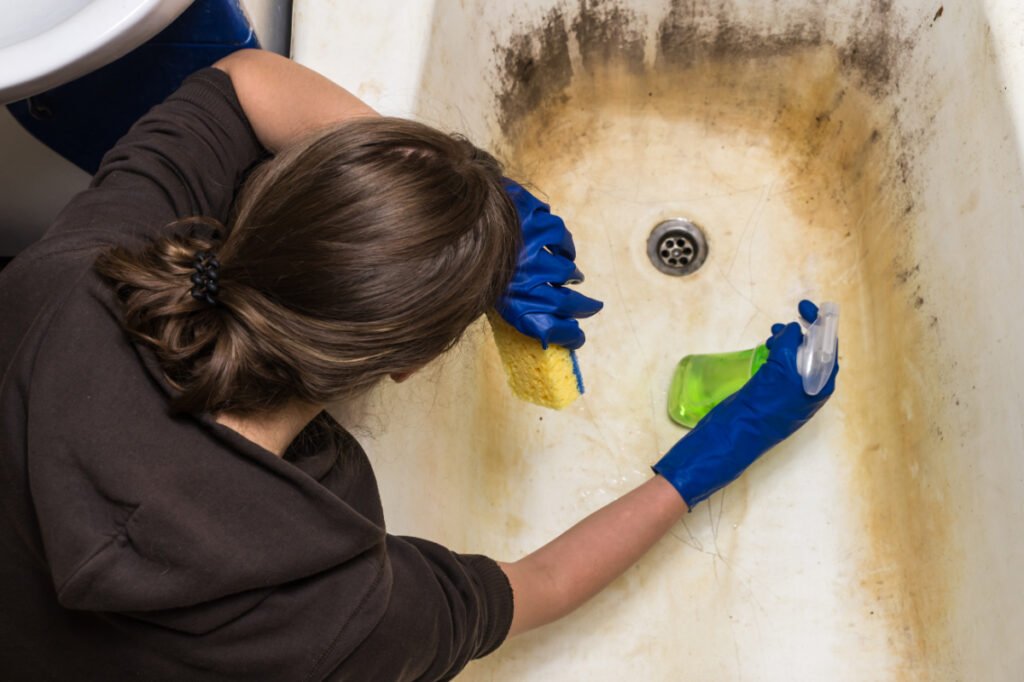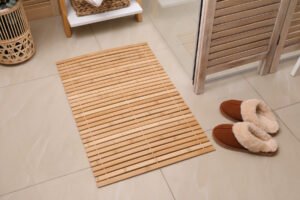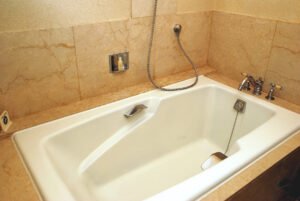A bathtub is the most overused plumbing fixture in any bathroom and suffers from its share of daily abuse. The accumulated soap scum, mildew attacks, and fungus deteriorate the tub surface and might stain or discolor it.
And as unhealthy as it is, a dirty bathtub isn’t the first thing you want to see in your bathroom, right?
So today, I will share some of the coolest tips and tricks to deep clean a tub. These hacks will enhance your bathtub cleaning routine so you can enjoy a clean, hygienic bath every day!
How to Remove Mildew from a Bathtub?
The wet, heavy-moisture settings of most bathtubs make them prone to mildew and fungus. The bathroom’s warmth and humidity accelerate their growth and further deteriorate the tub surface.
So, let us look at some quick hacks to remove different types of mildew from any bathtub.
Hacks to Remove Black Mold

Black mold is a toxic, slimy microfungus that causes skin and eye irritation, triggers allergies, and causes lethargy.
Hence, inspecting the tub for any black mold spots and removing them immediately with one of the methods mentioned below is advisable.
1. Dampen with Bleach
Simply soak cotton balls or strips in a solution of one part of chlorinated bleach and two parts of water and spread those on the tub surface.
Allow them to sit the whole night, rinse the tub with any cleaning product in the morning, and watch all the mold flow away.
2. Apply Baking Soda
Mix baking soda, dish soap, and water equally and brush this paste onto the mold. Let it sit for 10 minutes, and wash it off with hot water later.
Baking soda is also effective in cleaning faucets and shower heads. Here is how to clean shower heads with baking soda and vinegar.
3. Spray Vinegar
Spray concentrated, distilled white vinegar onto the mold, let it sit for 5-7 minutes, and then scrub it off using a good quality cleaner and microfiber cloth.
4. Create a Seal
Apply a grout sealer on your caulk and tub corners to curb the spread of black mold into the tub.
Hacks to Eliminate Green Mildew

Green mildew is a powdery, foul-smelling fungus that grows on the corners and upper edges of metal and acrylic tubs. This mildew can cause wheezing, nasal congestion, or sinus attacks.
You can easily remove green mildew from your bathtubs with one of the effective ways mentioned below.
5. Spray Hydrogen Peroxide
Spray concentrated hydrogen peroxide solution on the mildew, and scrub it using a soft scrub pad or a scouring brush. Later, rinse the tub using clean water.
6. Use Bleach
Bleach works like magic and not only removes the mildew but also disinfects the area.
Mix one part of oxygen bleach with two parts of water, spray it directly onto the mildew-affected area, and rinse it with cold water after five minutes.
7. Apply a Mildew Remover
Use a heavy-duty mildew remover such as Clorox or CLR, scrub it a little, and have a clean bathtub in no time. And this hack even works for jacuzzis and jetted tubs.
Hydrogen peroxide and bleach are abrasive substances and might damage the bathtub if left longer. Hence, always rinse them after a maximum of five minutes.
Hacks to Get Rid of Bathtub Fungus

Bathtub fungus is a group of several yeasts, mushrooms, and toadstools that spread along the bathtub edges or overall surface.
This fungus may turn the water slimy and cause athlete’s foot or yeast infections in humans.
You can quickly kill the fungi with the hacks mentioned below.
8. Spray Borax
Mix one cup of white borax with one gallon of water, add it to a spray bottle, and spray it on the surface directly.
Then, rinse it further with a bathtub cleaner or toilet bowl cleaner to eliminate all the spores, and You’re done!
9. Dry the Tub
Run a dehumidifier in your bathroom, turn on the exhausts, and dry the fungus. Then scrub the tub properly to take the fungi out easily.
How to Wipe Out Other Bathtub Problems?
Bathtubs are susceptible to molds and mildew, but many more problems like rusting, staining, or watermarks need attention and cleaning.
So, let us look at the hacks to solve your regular bathtub problems.
Hacks to Clear Bathtub Rust

Rust is nothing but the brown and green patches on metal or copper tubs or metal bathtub faucets that do not dry out properly after use.
You can clear bathtub rust and restore your bathtub’s color using the following hacks.
10. Elbow Grease
Moisten the rust with elbow grease, rub for a few minutes, and scrub it away. Then, rinse the tub with an anti-rust solution, and wash off the grease with any standard tub cleaner.
11. Pumice
Pumice stones are perfect for removing rust from easily scratchable materials like Acrylic and Porcelain.
Simply dampen the rust and rub the stone in circular motions above it to see the magic!
12. Use Lemon and Salt
Mix lemon juice and salt in equal quantities to form a paste. Apply this paste over the rusted areas, leave it for 15 minutes, and rinse it later with any bathroom cleaner.
13. Use Rust Removers
Use good-quality rust cleaners or all-purpose solutions to oxidize the rust and remove it without scrubbing.
Rust-removing liquids are highly flammable and might cause burns on your skin. Hence, always wear your safety gloves and goggles when handling one.
Hacks to Erase Hard Water Stains

Hard Water stains are nothing but calcium accumulation on the top surface of the tub. It reduces the natural shine of the bathtub and looks unsightly.
Here’s how to effectively remove these stains from your tub.
14. Soak in Apple Cider Vinegar & Water
Spray a solution of apple cider vinegar and water over the tub surface, let it sit for 20-25 minutes, and wash it off. This will dissolve all the calcium crystals and restore your tub’s shine.
15. Try Lemon or Tea-tree Oil
Lemon or tea tree oil pulls off the mineral deposits on the tub’s surface and adds more shine. However, it might make the tub slippery.
16. Work with Cleaner Scrubs & Vinegar
Mix a good-quality cleaner scrub with 2-3 tablespoons of white vinegar and apply it over the discolored area. Let it sit for 15-20 minutes, then rinse it with a non-abrasive or shower cleaner.
17. Mix Tartar & White Vinegar
Tartar enhances white vinegar’s acidic nature and helps easily remove all the calcium deposits.
Spray it over the bathtub surface, scrub it a little, and then dry the tub using a microfiber cloth.
18. Apply Peppermint Oil & Coconut Oil
Mix 5-6 drops of Peppermint oil in half a cup of Coconut oil and spread it evenly on the tub surface. Let it sit for 15 minutes, then buff it with some tissues for a smooth surface.
19. Use Toothpaste
Toothpaste is basic in nature and neutralizes acidic mineral deposits, thus removing them efficiently.
Squirt some toothpaste on the hard water stain, scrub it a little, and wipe it away.
Hacks to Erase Yellow Stains

Yellow stains are hideous and not only make your bathtub look older and worn out but also disrupt your overall bathroom decor.
These stains are pretty common in acrylic and fiberglass tubs; hence, it might be handy to know some tips to get rid of them.
20. Ensure Proper Ventilation
Generally, bathtubs turn yellow if they do not dry properly. So ensuring proper ventilation is a quick way to ensure drying.
Turn on those exhaust fans, open the ventilators, add dehumidifiers, and have a white tub again.
21. Spray Balsamic Vinegar
Balsamic vinegar will not only dissolve a chemical stain but will absorb all the foul smells and make your bathtub as good as new.
Simply spray some vinegar on the stain, cover it with a paper towel, let it sit for about 15 minutes, and rinse it immediately.
22. Rinse with Chlorine
Chlorine removes tough stains within minutes, reduces the odor, and disinfects the tub.
All you have to do is sprinkle some powdered chlorine or solution on the yellow stain, wait for 10 minutes, and then scrub it with a soft-bristled toothbrush.
Chlorine is abrasive and causes fumes that might irritate the skin and the eyes. So, never forget to wear your gloves and protective glasses.
Tips to Clean Bathtub Jets

Bathtub jets are small and uncovered. Hence, they are prone to clogging, staining, or foul smells and need frequent cleaning for optimal function and clean sprays.
So, let’s discuss some quick hacks that unclog your jets and optimize your jacuzzis.
23. Run Fresh Water After Use
Cleaning your jets with fresh water ensures quick removal of soap scum, grime, and grout and facilitates proper aeration.
Simply fill the tub with 2-3 inches of fresh water, run the jets for 5 – 10 minutes, and empty the water to drain out all the flakes and grime.
24. Use a Dental Floss
Dental floss is thin and flexible and allows you to reach all those places where a simple toothbrush can’t scrub.
So, floss your jet covers, wash them a little and rinse with an abrasive cleaner and warm water to remove all the flakes.
Tips for Cleaning Different Bathtub Materials

Generally, bathtubs are available in a wide range of materials – metals, non-metals, acrylic, porcelain, and of course! Each one has its considerations, tips, and cleaning hacks.
So, let’s learn some quick tips to clean some popular bathtub materials effectively.
25. Clean Your Acrylic Bathtub with Hydrogen Peroxide, Borax & Baking Soda
Acrylic is a brittle, easily scratched material and cannot endure chemical cleaning or brushing. Hence, you must use a non-scrubbing cleaner to clean your acrylic bathtub.
You can make your DIY cleaning solution at home by mixing one part of hydrogen peroxide with two parts of baking soda and water and use it to remove all those yellow stains quickly.
You can also use a thick paste of borax and water to remove the rust from your acrylic tub.
26. Reglaze a Fiberglass Bathtub with Hydrogen Peroxide and Tartar
Fiberglass tubs turn yellowish and lose their glaze quickly, but you can whiten them again using a DIY cleaner of hydrogen peroxide and tartar.
Mix about 6 ounces of hydrogen peroxide with 12 ounces of tartar, add a little water, scrub your tub, and watch all those tough bathtub stains disappear like magic!
27. Use a DIY Cleaner for Your Porcelain Bathtub
Porcelain is a comparatively fragile material and gets damaged due to any abrasive cleaner, vinegar, or bleach.
So you can prepare a mild DIY cleaner for your porcelain bathtub by mixing 2-3 spoons of dish soap with a gallon of water and adding a few drops of lemon oil for a shiny appearance.
Limit cleaning any porcelain bathtub only once a month, as frequent scrubs might scratch the surface and look weathered.
28. Clean Metal Bathtubs with a TriSodium Phosphate Cleaner
Metal bathtubs are vulnerable to rust, mold attacks, and mildew. A commercial trisodium phosphate cleaner will not only remove all the tough stains but also peel off the rust layer and mildew.
Simply mix a teaspoon of the cleaner in a glass of warm water, spray it over the tub, and rub it off with a rag later.
You can spray any anti-rust solution on the tub’s surface and give a final rinse with vinegar to prevent corrosion and weathering.
General Hacks for a Weekly Bathtub Cleaning Routine

Be it a traditional bathtub or bathtub alternative, regular cleaning or rinsing once a week is an excellent way to retain its shine and prevent soap scum accumulations that might be tricky to scrub off later.
However, you cannot use stronger abrasive cleaners or bleach now and then; instead, you need mild cleansers.
So, let’s discuss some general hacks for a weekly bathtub cleaning.
29. Use a Mild Grime Cleaner
Milder grime fighters and anti-grime solutions like ‘Scrubbing Bubbles’ remove minor stains, grime, and grout without scrubbing or reacting with the bathtub’s surface.
All you need to do is spray the cleaner on the tub, let it foam, and then wipe it off after 10 minutes.
30. Scrub with Dryer Sheets
Dryer sheets are pretty gentle and do not erode the tub’s surface.
Simply soak the sheets with any fabric softener, press them a little, and rest them on the tub’s surface for about 15 minutes, and you are good to go!
31. Purchase a Drain Catcher
Drain catchers add an extra filter that prevents hair clogs, soap, and stain accumulations and helps you empty all the dirt in one go. So, a good-quality drain catcher is a must-buy for all those busy households.
32. Use a Magic Eraser
Magic Eraser is a sponge-like all-purpose cleaner that removes the dirt accumulations along drain rings, tub edges, and corners and makes them sparkling white in no time.
Thus, good-quality magic erasers like ‘Mr. Clean Magic Eraser’ is a great tool to scrub off specific parts without cleaning the whole bathtub.
33. Scrub with Grapefruit & Salt
Simply dip a Grapefruit in Epsom or Rocksalt, rub it on your tub, and watch all those hard water stains disappear like magic. It will also add a lovely citrus fragrance to your tub.
Tips for Effective Bathtub Cleaning
- Do not leave your soap or shampoo bottles on the bathtub’s edge, as these cause marks and might discolor the tub.
- Never use any steel wool or scrubber to rinse your bathtub, and always pick softer brushes, scouring pads, or paper tissues for this purpose.
- Do not work with chemical cleaners in a poorly ventilated bathroom; always switch on your exhaust fans before doing so.
- Rinse the tub surface and wipe off the excess moisture every time you take a bath. This will help prevent mildew and any fungal growth.
What Is the Fastest Way to Clean a Soiled Bathtub?
A solution of warm water and vinegar removes all mud stains and yellowness from a bathtub and makes it sparkling white. Simply mix 1oz vinegar in 2 ounces of water, spray it over the tub, and rinse it after 20 minutes. You can even add lemon juice to remove any oiliness and bacteria from the surface.
How Do You Clean a Soiled Tub Without Scrubbing?
Mix mild dish soap, vinegar, and water in a spray bottle, and spray it onto the tub’s surface. Let it rest for about 30 minutes, and then you can peel off all the mud layers without scrubbing.
What Kind of Vinegar Should You Use to Clean Bathtubs?
Generally, white vinegar and apple cider vinegar is used for cleaning bathtubs. But white vinegar is a more potent disinfecting agent, while apple cider vinegar is much milder and adds a citrus smell.
Deep bathtub cleaning is undoubtedly a time and labor-intensive job, but the above hacks will give you a clean bathtub. Most of them use household products, kitchen items, readily available accessories, and easy techniques.
Be it a conventional tub or a jetted bathtub, all you need to do is retain some water in the tub, push the dirt and grime in it, use soap, and drain it out. The right bathtub drain stopper will help with that. You can find the perfect bathtub drain stopper types for your bathtub, here!









